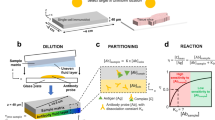Abstract
In this work, we report on a simple process for fabricating a hydrophobic/hydrophilic hybrid-patterned microarray chip for a fast and sensitive immunoassay. Two different types of self-assembled monolayers (SAMs) were used in the fabrication of hydrophilic well patterns and hydrophobic substrates. The hydrophilic/hydrophobic hybrid SAM pattern generates a clear-cut boundary between the sample and the background. A change in the precursor molecules allows for many different types of SAMs to be employed in the fabrication process. Fluorescence image-based detection has previously been used for the quantitative immune-analysis of a specific cancer marker. Here, a titanium-coated glass substrate was utilized to suppress auto-fluorescence signals from substrate backgrounds. Angiogenin (ANG), a small polypeptide implicated in both angiogenesis and tumor growth, was used as a target cancer marker for its validation. Assay results demonstrate that the hybrid-patterned array chip yields a narrower error deviation and a lower coefficient variation than in a conventional 96-well plate ELISA. Furthermore, the sample requirement (1 μL) for the hybrid-patterned chip is about 50 times less than that required in an ELISA (at least 50 μL). The proposed hydrophobic/hydrophilic hybrid-patterned microarray chip is expected to be a highly efficient tool that can be applied to a high throughput immunoassay of a specific cancer marker.
Similar content being viewed by others
References
Glökler, J. & Angenendt, P. Protein and antibody microarray technology. J. Chromatogr. B 797, 229–240 (2003).
Joos, T.O. et al. A microarray enzyme-linked immunosorbent assay for autoimmune diagnostics. Electrophoresis 21, 2641–2650 (2000).
Angenendt, P. Progress in protein and antibody microarray technology. Drug Discov. Today 10, 503–511 (2005).
Kang, S.H. & Islam, M.S. Biosensors on array chip by dual-color total internal reflection fluorescence microscopy. BioChip J. 3, 97–104 (2009).
Jang, H.J., Cho, Y.W. & Lee, E.K. Proteochip-based immunoassay method for quantitative determination of serum tumor markers. BioChip J. 3, 171–180 (2009).
Lee, J. et al. Microarray of stimuli-responsive microbeads for duplexed immunoassay. BioChip J. 5, 158–164 (2011).
Deegan, R.D. et al. Progress in protein and antibody microarray technology. Nature 389, 827–829 (1997).
Kajiya, T., Kaneko, D. & Doi, M. Dynamical visualization of coffee stain phenomenon in droplets of polymer solution via fluorescent microscopy. Langmuir 24, 12369–12374 (2008).
Moran-Mirabal, J.M. et al. Controlling microarray spot morphology with polymer liftoff arrays. Anal. Chem. 79, 1109–1114 (2007).
Zhang, H., Lee, Y.Y., Leck, K.J., Kim, N.Y. & Ying, J.Y. Recyclable hydrophilic-hydrophobic micropatterns on glass for microarray applications. Langmuir 23, 4728–4731 (2007).
Yin, L.T., Hu, C.Y. & Chang, C.H. A single layer nitrocellulose substrate for fabricating protein chips. Sensor Actuat. B-Chem. 130, 374–378 (2008).
Chang, Y.J., Hu, C.Y., Yin, L.T., Chang, C.H. & Su, H.J. Dividable membrane with multi-reaction wells for microarray biochips. J. Biosci. Bioeng. 106, 59–64 (2008).
Jang, L.S. & Liu, H.J. Fabrication of protein chips based on 3-aminopropyltriethoxysilane as a monolayer. Biomed. Microdevices. 11, 331–338 (2009).
Critchley, K. et al. A mild photoactivated hydrophilic/hydrophobic switch. Langmuir 21, 4554–4561 (2005).
Cha, N.G., Echegoyen, Y., Kim, T.H., Park, J.G. & Busnaina, A.A. Convective assembly and dry transfer of nanoparticles using hydrophobic/hydrophilic monolayer templates. Langmuir 25, 11375–11382 (2009).
Mani, G. et al. Stability of self-assembled monolayers on titanium and gold. Langmuir 24, 6774–6784 (2008).
Pérez-Luna, V.H. et al. Fluorescence biosensing strategy based on energy transfer between fluorescently labeled receptors and a metallic surface. Biosens. Bioelectron. 17, 71–78 (2002).
Wu, H.P., Cheng, T.L. & Tseng, W.L. Phosphate-modified TiO2 nanoparticles for selective detection of dopamine, levodopa, adrenaline, and catechol based on fluorescence quenching. Langmuir 23, 7880–7885 (2007).
Yoshioka, N., Wang, L., Kishimoto, K., Tsuji, T. & Hu, G. A therapeutic target for prostate cancer based on angiogenin-stimulated angiogenesis and cancer cell proliferation. Proc. Natl. Acad. Sci. USA 103, 14519–14524 (2006).
Srisa-Art, M. et al. Analysis of protein-protein interactions by using droplet-based microfluidics. Chem. Bio. Chem. 10, 1605–1611 (2009).
Chang, S.I. et al. Detection, quantitation, and localization of bovine angiogenin by immunological assays. Biochem. Biophys. Res. Commun. 232, 323–327 (1997).
Author information
Authors and Affiliations
Corresponding author
Rights and permissions
About this article
Cite this article
Lee, M., Kim, K.H., Park, JG. et al. Fabrication of a hydrophobic/hydrophilic hybrid-patterned microarray chip and its application to a cancer marker immunoassay. BioChip J 6, 10–16 (2012). https://doi.org/10.1007/s13206-012-6102-y
Received:
Accepted:
Published:
Issue Date:
DOI: https://doi.org/10.1007/s13206-012-6102-y




